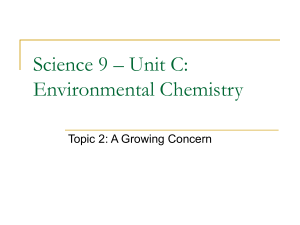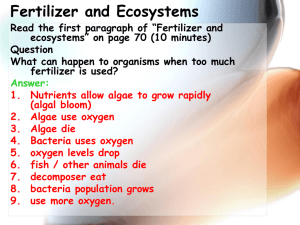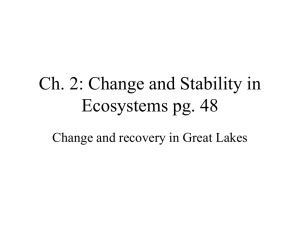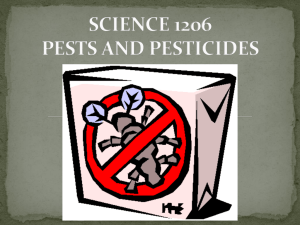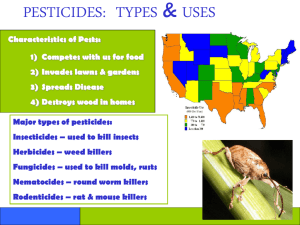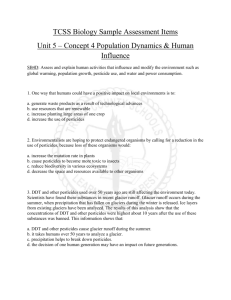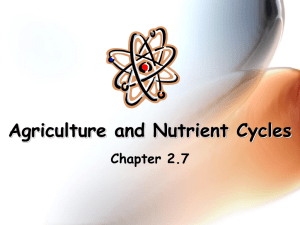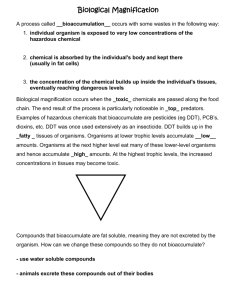Answers to 2.2 Possible answers include: dandelions are
advertisement
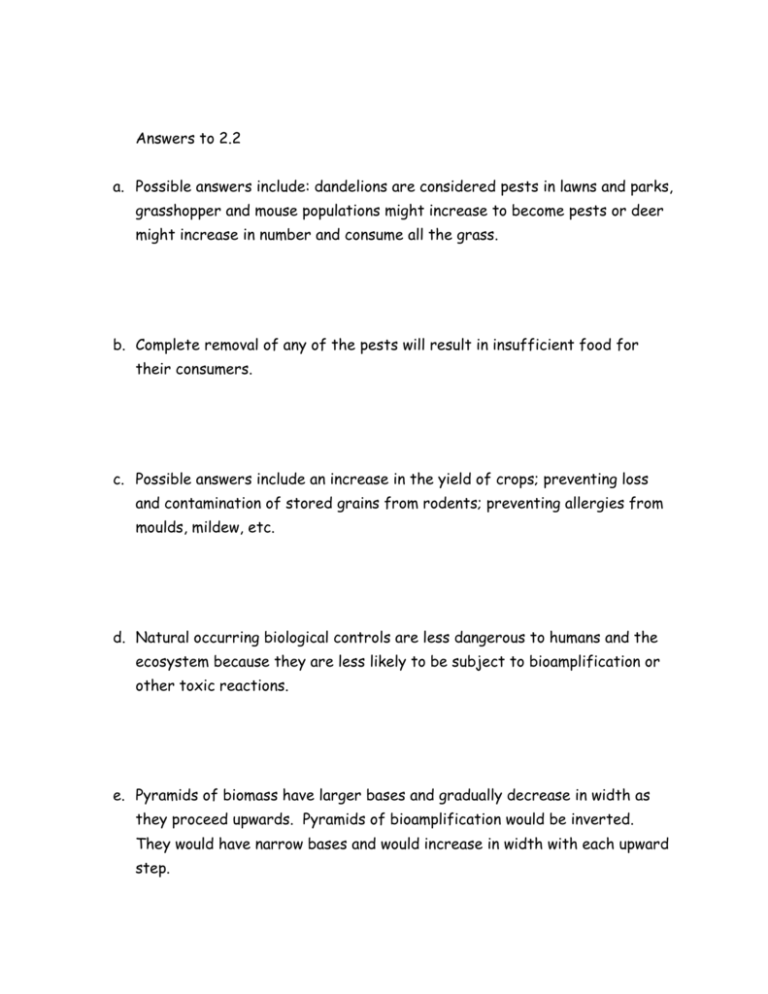
Answers to 2.2 a. Possible answers include: dandelions are considered pests in lawns and parks, grasshopper and mouse populations might increase to become pests or deer might increase in number and consume all the grass. b. Complete removal of any of the pests will result in insufficient food for their consumers. c. Possible answers include an increase in the yield of crops; preventing loss and contamination of stored grains from rodents; preventing allergies from moulds, mildew, etc. d. Natural occurring biological controls are less dangerous to humans and the ecosystem because they are less likely to be subject to bioamplification or other toxic reactions. e. Pyramids of biomass have larger bases and gradually decrease in width as they proceed upwards. Pyramids of bioamplification would be inverted. They would have narrow bases and would increase in width with each upward step. f. The higher the trophic level of the dead organisms consumed by the scavengers, the greater would be the amount of bioamplification. g. DDT can be transferred to organisms in Canada by migrating fish, sea mammals, and songbirds. It can also be found in imported foodstuffs. h. If DDT has accumulated in animals that are eaten by humans, it can be stored in human breast tissue and passed on to a baby in breast milk. i. Newer pesticides are water soluble and cannot accumulate in fat tissue. j. Insects resistant to pesticides survive applications of the chemicals and have less competition for the available food. Consequently, they would be more likely to reproduce and more offspring would survive. k. The greatest increase in the number of resistant species occurred in the decade between 1970 and 1980. The number of species becoming resistant to a particular pesticide increases with the length of time that the pesticide is in use. l. Spruce budworms have become resistant to the pesticides available. If all of the pests are not wiped out in the first wave, the survivors can multiply I number. m. Concentrations of pesticide sufficiently high to kill all the spruce budworms would also kill many other species, beneficial as well as harmful, insects as well as other organisms. n. The loggers and lumber and paper-mill workers have benefited from the New Brunswick spraying program. o. The loggers, lumber and paper mill workers and First Nations peoples depending on the forests for a livelihood, might have lost out as a result of the decision not to spray o Cape Breton Island. p. Not spraying on Cape Breton Island has allowed the ecosystem to adjust and naturally recover from the spruce budworm infestation. q. DDT builds up in fat tissues and both bioaccumulation and biooamplification occurs. Top predators, such as herons and hawks, and those species that are both predators and scavengers, such as gulls, would suffer the consequences and could become endangered. r. Since the only release of toxins from the body of an eagle is through egg laying, male eagles have no means of reducing the concentration of toxins during their 25 year lifespan. s. The food web should show pesticides moving from phytoplankton to zooplankton; to shellfish, insects, and fishes; to medium sized fish, to larger fish, to herons, ducks, hawks, and gulls. 1. A pest is any organism that people find harmful or inconvenient. A pesticide is any substance that is used to control a pest. 2. A diagram should show an inverted pyramid in which the lower levels have the least amount of pesticides and succeeding steps have increasing amounts. 3. A) Arsenic, lead and mercury are toxic materials that accumulate in the body. Humans and animals eating the crops could be poisoned over time. These materials are also subject to bioamplificaiton, which means they would be found in higher concentrations in organisms higher up the food chain. B) DDT is not water soluble but accumulates in fat. It also is subject to bioamplification us the food chain. C) Since water soluble pesticides break down more readily, it is necessary to use them more frequently. Therefore, organisms higher up the food chain are still subjected to more pesticide because of the application frequency. 4. Two advantages of low toxicity, rapid breakdown pesticide is theta it does not accumulate in fat tissue and does not bioamplify. Two disadvantages are that it has to be applied more frequently another organisms are subjected to repeated doses. 5. Water soluble, long acting pesticides can contaminate ground water and accumulate in streams, rivers and lakes. 6. Humans can’t adapt to toxic pesticides as quickly as insects because we have a much longer reproductive cycle. Many insect generations are measured in weeks or months. A human generation is 18 or more years. 7. a) DDT enters a marine system through sprays that contaminate waterways, especially coastal marshes when attempts are made to control malaria carrying mosquitoes and other insects; through run off from fields; and through food chains I which marine birds and mammals eat organisms in which DDT has accumulated. b) Even though DDT has been banned I Canada for decades, animals still carry it in their bodies because it accumulates I fat tissue and cannot be excreted. c) DDT levels fall more slowly in porpoises because they have fairly long lives and they eat large quantities of organisms that might contain DDT.
